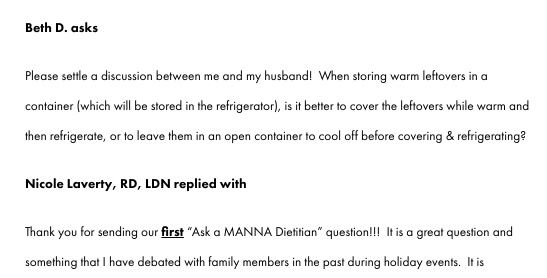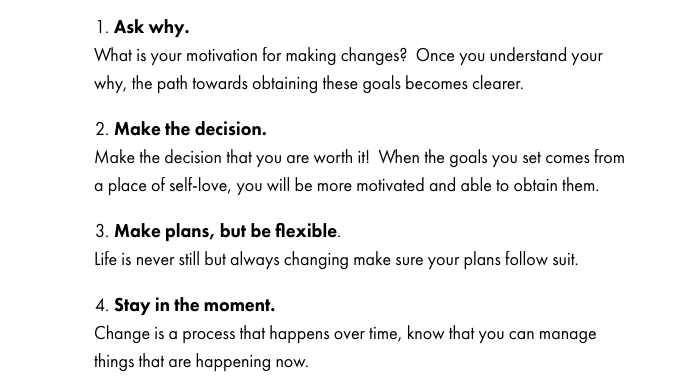We’re Here to Help!
In an effort to provide our community of supporters, volunteers, and clients with helpful nutrition tips, we have begun an “Ask a Dietitian” series that will be promoted on our blog and social media.
Beth D. asks
Please settle a discussion between me and my husband! When storing warm leftovers in a container (which will be stored in the refrigerator), is it better to cover the leftovers while warm and then refrigerate, or to leave them in an open container to cool off before covering & refrigerating?
Nicole Laverty, RD, LDN replied with
Thank you for sending our first “Ask a MANNA Dietitian” question!!! It is a great question and something that I have debated with family members in the past during holiday events. It is important to follow safe food handling when dealing with leftovers to prevent food-borne illness. First, you want to make sure that you cook your food to a safe, minimum internal temperature using a food thermometer (145 ° F for red meats, 160 ° F for ground meats, and 165 ° F for poultry). After preparing your food, you want to keep your food out of the “Danger Zone” (40 ° F – 140 ° F). Hot food must be kept hot at 140 ° F or warmer and cold food at 40 ° F or less for two hours or less, at or after that 2 hour time period you must either refrigerate your leftovers or throw the food away. To answer your specific question, it is important to cool your cooked food rapidly so that it reaches the safe refrigerator-storage temperature of 40 ° F or below. Divide large amounts of food into shallow containers and cut large items of food into smaller portions to cool. Hot food can then be placed directly in the refrigerator or be rapidly chilled in an ice or cold water bath before refrigerating. It is also important to cover or seal your leftovers in airtight packaging to help keep bacteria out, retain moisture, and prevent leftovers from picking up odors from other foods in the fridge. Immediately refrigerate or freeze the wrapped leftovers for rapid cooling. You can keep your leftovers in the refrigerator for up to 3 to 4 days or frozen for 3 to 4 months.
Amanda P. asks
I know that consuming too much sugar can lead to health concerns like diabetes and obesity, but I’ve recently heard that a calorie is just a calorie and it’s not what you eat that matters, is that true?
Nicole Laverty, RD, LDN replied with
Because sugar lacks fiber and other healthy nutrients, its rate of metabolism – how quickly your body breaks it down – is fast. This means that refined sugar is quickly broken down into glucose and fructose.
Glucose spikes insulin (a hormone) and blood sugar levels, which gives you a quick surge of energy that your body cannot use right away. This high insulin level increases storage of belly fat and increases inflammation, and it also affects the chemistry of your brain and increases your appetite by blocking leptin – the appetite-control hormone. When you become leptin resistant your brain never gets the “full” signal, and instead thinks that you are starving, causing you to consume more calories.
Fructose is metabolized in your liver and absorbed at once, increasing fat cell production and the workload on your liver. It also triggers more insulin resistance and causes elevated blood insulin levels, which result in the body storing everything as belly fat. This is not healthy, and also generates more inflammation, worsening insulin resistance and leading to weight gain and diabetes.
On the other hand, while fruit is also made mostly of glucose and fructose, their chemical and plant structures are different from refined sugar in ways that alter the absorption rate and effects on the body. Fruit is rich in antioxidants, phytonutrients, vitamins, and minerals. It is also a great source of fiber, which refined sugar lacks entirely. The fiber naturally occurring in fruit expands your gut, helping you to fell fuller for longer. It also prevents the sugars in fruit from being broken down as rapidly and prevents the crazy insulin spike, allowing your body more time to use up the glucose as fuel before storing it, and decreasing the metabolic stress on your body.
Have a question for our staff? Send them to info@mannapa.org and we’ll answer them here! Responses will also be shared on MANNA’s Facebook page and in our monthly e-newsletter.

